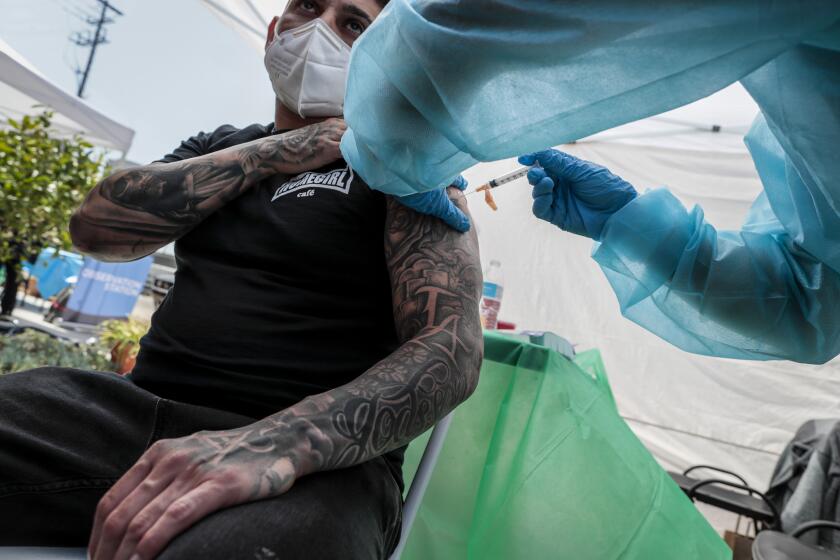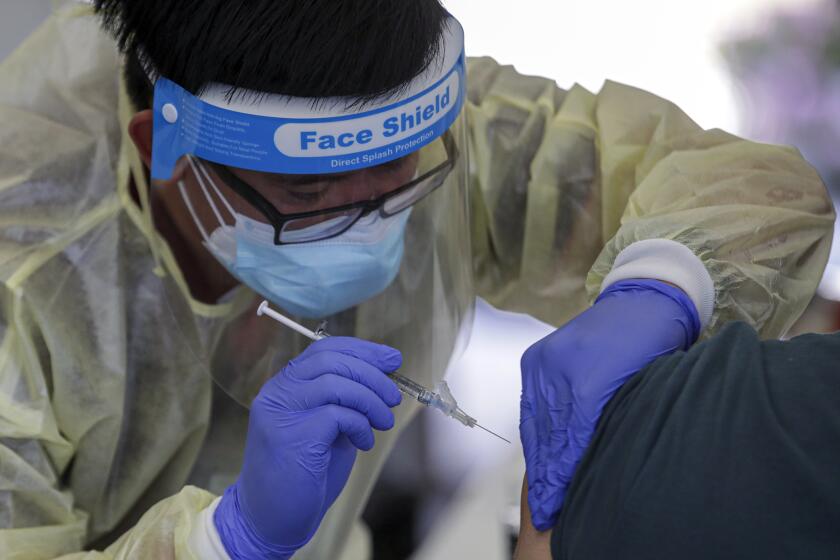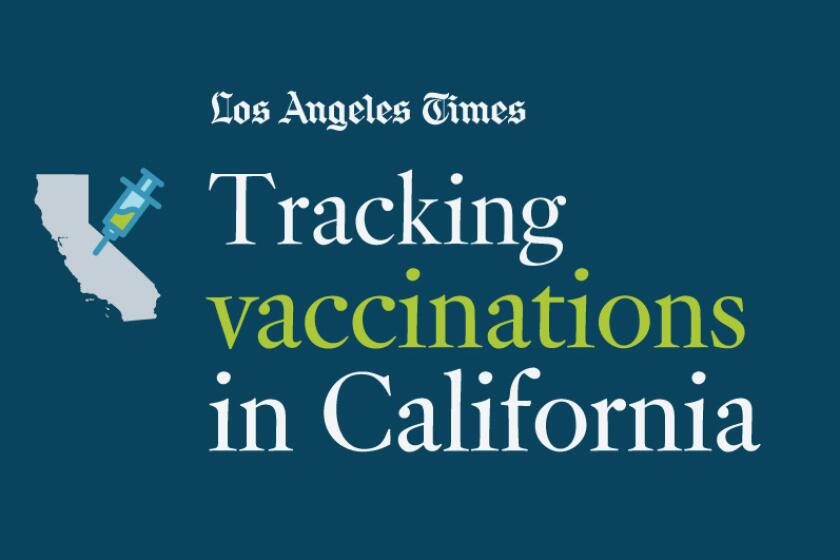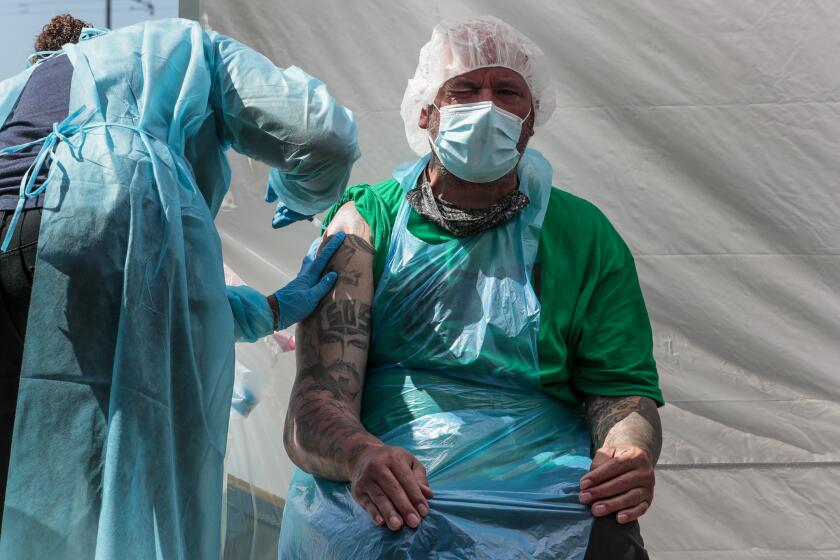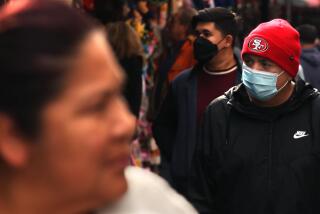Are herd immunity and the California coronavirus variant preventing a West Coast spring surge?
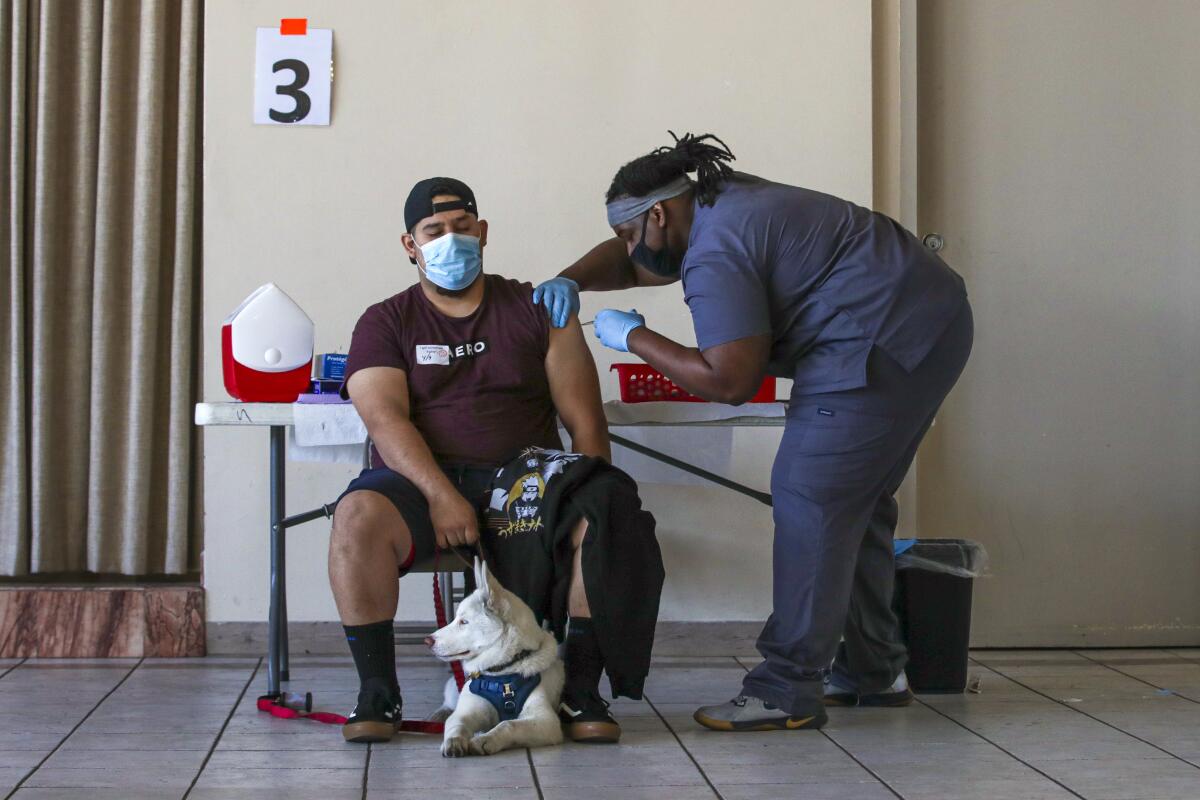
With coronavirus cases and related hospitalizations climbing nationwide, is California also headed for a fourth wave in the COVID-19 pandemic?
Coronavirus cases have risen in the Midwest, New England and the New York area, and there’s concern that Los Angeles County could be — as it has been in the past — only a few weeks behind trends coming out of New York. In the last week, average daily coronavirus cases nationally are up 3% over the previous week and daily COVID-19 hospital admissions are up 7%.
But so far, California remains in good shape, relatively speaking. California had one of the lowest average daily coronavirus case rates in the nation over the most recent seven-day period, while Michigan’s case rate — the worst in the nation — was 12 times higher than California’s, placing growing strain on hospitals there.
One factor that may be helping California — for reasons not fully understood — is the presence of the California variant. The California variant here might be helping to keep a lid on the U.K. variant, which is believed to be more transmissible than the conventional strains of the coronavirus and likely results in more severe illness and, as a result, a greater chance of death.
Here are some reasons why Michigan might be doing so badly while California — so far — seems to be doing far better.
Your questions about vaccination-related civil liberties, privacy and discrimination are answered.
The U.K. strain is dominating the Midwest outbreak
Michigan’s current wave has become nearly as intense as at the height of the state’s winter surge, said Dr. George Rutherford, a UC San Francisco epidemiologist, at a recent campus forum. Michigan’s recent wave was spurred on by youth athletic events, including large outbreaks involving hockey teams, Rutherford said. Minnesota is also seeing a cluster of new cases.
A big factor in the Midwest surge is the presence of the U.K. variant, which now accounts for about 70% of Michigan’s and Minnesota’s new coronavirus cases, Rutherford said. Michigan is now seeing its hospitals under pressure from surges of patients, and some hospitals in the state are canceling nonemergency procedures and enacting pandemic surge plans, the Detroit Free Press reported.
One bright side, however, is that the cluster in New York, New Jersey, Rhode Island and Connecticut seems to be “starting to turn the corner a little bit,” Rutherford said.
An outstanding question is whether the surge in COVID-19 in the neighboring Canadian province of Ontario is affecting the surge in cases in the Midwest and Northeast, Rutherford said. “The borders are closed, [so] I’m not quite sure what that all means. But it’s something to be cognizant of,” Rutherford said.
Doctors in Ontario have started to plead with government officials to send more intensive care unit nurses to the Toronto area “to avoid a triage situation,” the Toronto Star reported Saturday.
A past coronavirus infection may eliminate the need for a second dose of COVID-19 vaccine, a growing body of evidence suggests.
The California variant may be keeping the U.K. strain under control
In California, the U.K. variant now probably accounts for 40% of new coronavirus cases, Rutherford said, but unlike in Michigan, “it hasn’t driven the overall epidemic curve.”
Part of the reason for that is that the California variant may be dominating the U.K. variant in the state. Of virus samples that have been genomically sequenced cumulatively, more than 12,000 cases of the California variant — also known as the West Coast variant (B.1.427/B.1.429) — have been identified in California, compared with 980 of the U.K. variant (B.1.1.7).
The California variant is believed to be 20% more transmissible than the conventional coronavirus strains, but the U.K. variant is thought to be 50% more transmissible and more likely to cause worse illness.
Some experts have said they would presume that the U.K. variant would crowd out the California variant. But Rutherford said, somewhat counterintuitively, that the California variant may be somehow keeping the U.K. variant at bay.
Rutherford said he couldn’t fully explain it, but, “for whatever reason, they seem to be pushing it out of the way.” An upcoming study of coronavirus cases identified in San Francisco’s Mission District is expected to report almost no cases of the U.K. variant.
It’s possible that California will eventually be dominated by the U.K. variant, Rutherford said. “But for right now, we have way more of the [California variant],” he said.
If you had to choose between the California variant and U.K. variant being more dominant, the California variant is preferable, because it’s relatively less transmissible and deadly than the U.K. variant.
“If it was the U.K. variant [that was dominating California], we’d be in worse shape,” said Dr. Robert Wachter, chair of the UC San Francisco Department of Medicine, at the campus forum.
Relatively high rates of immunity may be helping California
The autumn-and-winter surge in California tore through many lower-income and heavily Latino communities, leaving behind a high death toll. These communities were particularly hit hard because many residents live in crowded homes and have jobs requiring them to leave home, exposing them to a higher risk of infection.
The intensity of the autumn-and-winter wave, however, has resulted in a large number of survivors who now have protection against coronavirus infections and COVID-19.
Officials estimate about 38% of L.A. County residents have been infected with the coronavirus since the start of the pandemic. And Rutherford said he suspects there are parts of L.A., such as in Boyle Heights and South L.A., in which half of residents have been infected.
Rutherford said it’s possible that California could reach something approaching herd immunity by June 15.
Experts say about most Americans will need to be vaccinated to bring the coronavirus pandemic under control. Track California’s progress toward that goal.
Michigan restrictions are not mandatory
So far, Michigan’s governor, Gretchen Whitmer, has declined to impose new mandatory restrictions to cope with the recent surge. On Friday, Whitmer called for a voluntary two-week suspension of indoor restaurant dining, youth sports and in-person high school classes, deciding against mandatory orders even though some doctors say they’re needed.
“No one wants another lockdown, but we need it,” tweeted Dr. Mona Hanna-Attisha, a pediatrician and author of “What the Eyes Don’t See: A Story of Crisis, Resistance, and Hope in an American City.” Hanna-Attisha won the Freedom of Expression Courage Award for her efforts to expose the dangerous levels of lead in the water in Flint, Mich.
On Monday, the director of the U.S. Centers for Disease Control and Prevention, Dr. Rochelle Walensky, said the answer to Michigan’s “extraordinary number of cases” was “really close things down, to go back to our basics, to go back to where we were last spring, last summer, and to shut things down, to flatten the curve, to decrease contact with one another.”
Walensky said the solution did not involve redirecting vaccine doses from other states to Michigan. Even if additional doses went into arms today, the effect would not be seen for two to six weeks. “If we tried to vaccinate our way out of what is happening in Michigan,” Walensky said, “we would be disappointed that it took so long for the vaccine to … actually have the impact.”
Following the autumn-and-winter surge, indoor restaurant dining in Michigan resumed on Feb. 1; L.A. County resumed indoor restaurant dining much later, allowing operations to reopen March 15.
National experts, including Dr. Anthony Fauci, the U.S. government’s top infectious diseases expert, have long been warning against states reopening businesses too quickly following the winter surge, fearing that a speedy reopening would result in a backsliding into another surge.
At the end of February, Fauci warned against moves by states to reopen too quickly. On CNN, Fauci noted that in past periods of the pandemic, “when we started to pull back prematurely, we saw the rebound. We definitely don’t want that to happen.”
Two COVID-19 vaccines are likely to be protective against a rapidly spreading variant of the SARS-Cov-2 virus that arose in California, a study finds.
What could cause problems in California?
Problems that could delay the end of the pandemic in California include the introduction of a new variant in California or the discovery of a problem with a vaccine that could undermine confidence in the shots, Rutherford said.
The vaccines now approved in the U.S. have proved themselves to be very effective and very safe, experts say. And the variants that pose a relatively higher risk of being resistant to vaccines — the South African and Brazilian variants — have yet to establish a firm hold in the U.S.
“The numbers of states with more than a few handful of cases of those is really vanishingly small,” Rutherford said. “I really haven’t seen it yet that makes me worry.”
More to Read
Sign up for Essential California
The most important California stories and recommendations in your inbox every morning.
You may occasionally receive promotional content from the Los Angeles Times.
